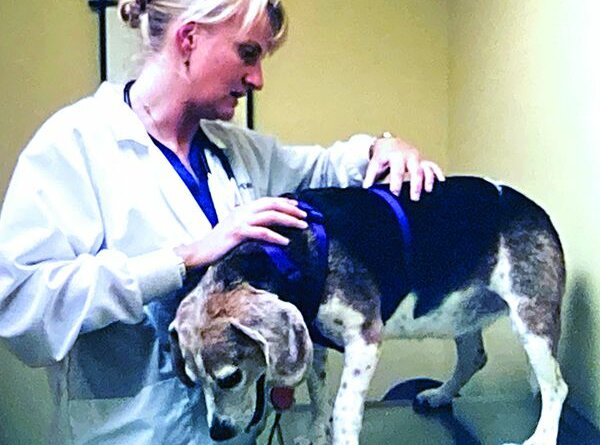What Causes Hind Leg Weakness in Dogs
When a dog suffers from weakness, regardless of cause, it’s usually most noticeable in the hind limbs first. This makes sense, as the dog’s hind limbs do a lot. They are responsible for pushing up from a sitting or laying position and for propelling the body forward during movement. Difficulty with these simple activities of daily life will alert you to a problem associated with weakness.
What does it look like? Slow to rise, sinking on hind limbs, dragging the tops of the toes, hind end swaying, limbs crossing sometimes, exercise intolerance, slipping, sliding, and hind-end collapse are all signs of hind-limb weakness.
If your dog is showing any of these signs, a couple of important observations you can make that will help your veterinarian determine the cause are:
- Is the weakness episodic or constant?
- Is it exercise-induced or not?
- Did it come on gradually or suddenly?
Your dog’s age and size will make some conditions more likely than others. This is also used in the diagnostic process.
Causes of hind-limb weakness can be categorized into four main groups: orthopedic, neurologic, metabolic, or cardiac.
ORTHOPEDIC CAUSES OF HIND-LIMB WEAKNESS
The main orthopedic cause of hind-limb weakness in dogs is chronic joint inflammation/pain (osteoarthritis, degenerative joint disease). While the arthritis itself is obviously painful, it is frequently accompanied by muscle aches and pains, called compensatory pain. The result is that it’s hard for the dog to get up and get moving. This may cause him to become more sedentary, resulting in loss of muscular strength and fitness, which compounds the whole situation.
Arthritis most commonly affects older dogs due to wear and tear on the joints over the years; overweight dogs bear an additional burden due to the excess stress those extra pounds put on the joints. Dogs with hip dysplasia (abnormally formed hip joints) may develop hip arthritis at a young age. Hind-limb weakness due to these arthritic conditions usually has a slow, insidious onset. It won’t seem like it happened overnight.
Acute forms of arthritis that can result in sudden weakness in the dog’s hind end include immune-mediated arthritis and Lyme arthritis. Other orthopedic causes of hind-limb weakness include fractures, intervertebral disc disease (IVDD), and bilateral anterior cruciate ligament (ACL) tears, which are common in overweight dogs. Blood tests and x-rays will help your veterinarian diagnose these conditions and prescribe appropriate therapy.
NEUROLOGIC CAUSES OF HIND-LIMB WEAKNESS
IVDD crosses over from an orthopedic probem to a neurologic one when a diseased disc (or discs) puts pressure on the spinal cord, resulting in neurologic weakness. Many of these cases can be managed medically, but if paralysis occurs or there is no improvement with medical therapy, surgery is indicated.
Spinal tumors and other neurologic conditions cause similar signs. Advanced imaging, such as computed tomography (CT) or magnetic resonance imaging (MRI), and sometimes cerebrospinal fluid analysis, is required for diagnosis.
Diskospondylitis is an infection of the intervertebral disc and the ends of the adjacent vertebrae. It is very painful, frequently causes hind-limb weakness, and can be difficult to diagnose. Treatment is antibiotics for an extended period of time (six to 12 months). Because this condition can be hard to diagnose in its early stages, your dog may require repeat x-rays and/or advanced testing like CT or MRI to get to a definitive diagnosis. Properly diagnosed and treated, these dogs can make a full recovery.
Lumbosacral stenosis, also known as cauda equina syndrome, is a degenerative condition similar to IVDD but specific to the lumbosacral joint. This is the joint connecting the last vertebrae to the pelvic area. It’s different from the other intervertebral joints in that it is where all the peripheral nerves that go to the hind end branch off from the spinal cord. Disease in this area is very painful and frequently causes neurologic deficits, resulting in hind-limb weakness.
Degenerative myelopathy (DM) is a slow but progressive degeneration of the spinal cord resulting in hind-limb weakness. It occurs in many breeds but the German Shepherd Dog is the poster child for this disease. It usually affects middle-aged and older dogs. There is currently no effective treatment for DM, just supportive care.
Myasthenia gravis (MG) is an autoimmune neuromuscular disorder that results in muscular weakness that comes on with exercise. It can start with the hind limbs, but rapidly evolves into full-body weakness and collapse.
Here’s a scenario that’s classic for MG: Your dog gets up from resting and is perfectly normal. You head out for your walk and within minutes, he is sinking, slipping, and staggering until he can no longer stand or walk. After a period of rest, which allows for replenishment of affected neuromuscular transmitters, he can once again function for a short time. Diagnosis requires a blood test. Treatment is long term (six months or longer). Some dogs will achieve remission and go on to live normal lives. Others will require treatment and support for life.
Exercise-induced collapse (EIC) is an inherited disorder in Labrador Retrievers and a handful of other breeds. It usually becomes apparent between 6 months and 2 years of age. It happens after several minutes of strenuous exercise. The dog suddenly becomes progressively weaker and uncoordinated in the hind limbs until he ultimately collapses. There is no treatment for this. Prevention involves avoiding strenuous exercise. For these reasons, it is important that you purchase your puppy from a breeder who has tested the parents for this gene. If you’ve adopted a dog with these symptoms, have him tested for the EIC gene.
Idiopathic vestibular syndrome is a common cause of incoordination and hind-limb weakness in geriatric dogs. It comes on suddenly, and it may seem to you as if your dog has had a stroke. The cause of this disorder is unknown. It is frequently accompanied by balance issues and a head tilt. Most dogs will recover in time with supportive care.
Several tick-borne diseases can cause generalized neuromuscular weakness that may first be apparent in the hind limbs. Tell your veterinarian if you have seen ticks on your dog.
METABOLIC CAUSES OF HIND-LEG WEAKNESS

Low blood sugar (hypoglycemia), low red blood cells (anemia), and low potassium (hypokalemia) are all examples of metabolic disorders that can result in hind-limb weakness. These are easily diagnosed with blood tests. Finding their underlying causes, which requires further diagnostic testing, is important for resolving these issues.
Underactive adrenal glands (Addison’s disease) and low thyroid hormone (hypothyroidism) are endocrine disorders that can cause weakness. Both disorders are diagnosed with blood tests, and treatment is for life.
Some liver conditions can result in a metabolic condition called hepatic encephalopathy, which causes episodic weakness and confusion, most obvious after eating a meal.
CARDIAC CAUSES OF HIND-LIMB WEAKNESS
Adequate cardiac function is essential for blood flow and oxygen delivery to all the body’s tissues. When cardiac function is impaired, regardless of cause, weakness results. Again, for the reasons previously stated, weakness in dogs is usually first apparent in the hind limbs.
Heartworm disease, congestive heart failure, heart muscle disease (cardiomyopathy), cardiac arrhythmias, cardiac or pericardial tumors, and fluid in the sac surrounding the heart (pericardial effusion) are all examples of cardiac diseases seen in dogs.
Your dog’s physical exam will clue your veterinarian into a cardiac cause for the hind-limb weakness you’ve identified, and diagnosis and treatment will move on from there.
HIND-LEG WEAKNESS IS NOT JUST CAUSED BY “OLD AGE”
As you can see, there are myriad potential causes of hind-limb weakness in dogs. This is why it is important to have your dog examined if you notice this issue – and never just dismiss it as an “old dog” issue. Your veterinarian can rule out many of the underlying causes and hopefully get to a definitive diagnosis. Identifying and treating some of these diseases can be life-changing for your dog, even if he’s quite senior!
For some chronic conditions, like osteoarthritis, there is no cure. But there is so much you can do to improve and maintain quality of life for your dog for a long, long time. It starts with your tender loving care and commitment to supportive measures.
Support for Arthritis-Related Mobility Issues

- Weight management. Everything is more difficult for overweight dogs.
- Joint supplements, such as glucosamine and chondroitin (I like Dasuquin by Nutramax), hyaluronic acid/egg shell membrane (I like Movoflex by Virbac), and/or polysulfated glycosaminoglycan (I like Adequan by Luitpold Animal Health).
- Fish oil supplements, which offer anti-oxidant and anti-inflammatory effects. (My favorites are Welactin by Nutramax and Nordic Naturals.)
- Anti-inflammatory medications. Nonsteroidal anti-inflammatory drugs (NSAIDs) such as deracoxib, carprofen, meloxicam, and others are the mainstay of pain relief for osteoarthritis. Always give these drugs with food to protect your dog’s stomach and have your dog’s kidney and liver function monitored at least twice a year while on these meds.
- Physical therapy, geared toward building and maintaining muscular strength. This can be pursued at a canine rehabilitation center, where underwater treadmill and other exercises will be incorporated into your dog’s individualized plan. But you can also do a number of exercises with your dog at home. Try “Puppy Push-ups,” for example: Have your dog sit, then stand, then down, then stand. Repeat. Slowly increase the repetitions like you would with your own fitness regime.
- You can also purchase an “instability” platform such as the K9FITbone (made by FitPAWS; see fitpawsusa.com). Standing on this inflated, rubbery platform helps build your dog’s muscles and body awareness. Start by teaching your dog to balance on the bone. Once he is comfortable standing on it, you can have him do his puppy push-ups on it! While he is standing, use a food lure to encourage him to slowly stretch his neck to his flank on both sides. These exercises are fabulous for core-strengthening, which helps combat hind-limb weakness.
- Laser therapy utilizes light energy at a particular wavelength known to reduce inflammation, relieve pain, and promote healing. It is administered by a trained professional into the tissue with a hand-held probe. Treatments usually start out twice a week for two to three weeks, then once a week for awhile, then as needed.
- Acupuncture reduces the pain of osteoarthritis and other painful disorders. It requires a skilled professional; see ivas.org to find trained veterinary acupuncturists. Some acupuncture practitioners also use herbal remedies that are formulated according to traditional Chinese medicine.
- Depending on your dog’s pain level, your veterinarian may prescribe pain medications such as tramadol, gabapentin, pregabalin, or amantadine.
- If your dog struggles to get up or has trouble on stairs, prevent further injury and help support him with a Help ‘Em Up Harness. It fits so comfortably that your dog can wear it 24-7 just like his collar. It has a handle over the shoulder blades and another handle over the hips, so you can reach down and help your dog with no delay – and no excess strain on your back! See helpemup.com for more information and videos of the harness in action.




